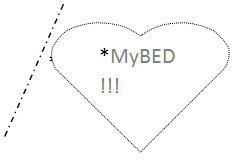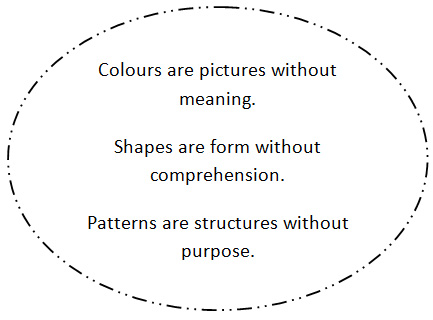The puzzle of life can be difficult to understand while the pieces remain scattered on the table (or on the bottom of a fast flowing stream.)
| Not of stone, a lighter structure have we, Yet on this stony bed we two are stuck. Seen only by the most observant. The currants of time Have us Jammed into an unnatural stillness. In this watery world of movement The ragged rocks have us captive. As we too await our unknown journey Into our concluding disappearance![The picture above is of a fast flowing stream and it includes two ivy leaves trapped amongst the stones] |
PuzzleRhymes and Riddles-Embracing Creative ThinkingSkills
Puzzles, rhymes and riddles involve creative thinking skills that go beyond the realms of our everyday language and verbal communication. They demand that the mind stretches beyond normal everyday thinking in order to meet new challenges and solutions through the powers of imaginative thought. One might consider at this point whether the ability to articulate is directed by thought processes -Thoughts to language or whether the thought processes are themselves directed by our level of language competence – Language to thoughts.
• Sapir and Whorf maintained that ‘our language must determine how we think.’
• Slobin proposed that ‘our language must influence our thinking although it does not determine it.’ (Cited in Hartland, 1991:28,30)
Like thequestion “Which came first the chicken of the egg?” the relationship between language and thought may remain speculative rather than conclusive.
Contrasting types of thinking
The contrasting lists below illustrate two types of thinking which the author describes as abstract and concrete; Steiner describes as ‘the musical elements’ and ‘the sculptural elements’ (Steiner,1982:52) and Fisher describes as ‘a division between creative thinking and analytical reasoning’.
‘Creative———————————-critical
Exploratory——————————analytical
Inductive——————————-deductive
Hypothesis forming—————-hypothesis testing
Informal thinking——————-formal thinking
Adventurous thinking————–closed thinking(Bartlett)
Left-handed Thinking————-right-handed Thinking(Bruner)
Divergent thinking———–convergent thinking(Guildford)
Lateral thinking—————vertical thinking(De Bono)’ (Fisher, 1990:32)
| When passion says ‘go’ and lifesays ‘stop’ ……….Definitely dodge past ‘compromise’ |
Hughes,(Children, Play&Development;Ally& Bacon, 1999) suggests there is an association between play, creativity and problem solving. He describes play as ‘intrinsically motivated’, ‘freely chosen’ and generally ‘pleasurable’. For creative play he extends this definition to include: imagination, personal characteristics that support an intellectual process towards a creative product. Hughes goes on to describe divergent problem solving as ‘the ability to branch out from a starting point and consider a variety of possible solutions’ and that this is often linked to the processes involved in creative thinking and fantasy play.
a) What is it?
Not three legs, not four legs, only one.
Not for people only fairies and toad wears the crown.
Six different Thinking Hats presented by Edward de Bono -:-
Red-Hat Thinking: emotions, feelings, intuition;
| Through many lifetimes we have searched for the song of freedom, And the closer it is the stronger the pains of separation. |
White Hat : objective information;
| If you cannot fly without crashing then walk, If you can’t walk without falling then crawl, For it’s not how fast you have travelled that’s important But rather, that you keep moving, safely forward. And it’s not how far you have travelled, But your condition on arrival, that directs your future. |
Black-Hat: caution, truth, reality;
| Silence – the absence of sound Darkness – the absence of light Stillness – the absence of movement Non-communication The absence of all three A trap of confusion |
Yellow-Hat : optimism, feasibility benefits;
| When sadness dwells all around And nothing seems to bring joy, Look inside to the comforting glow That makes you special. |
Green-Hat : creative ideas, suggestions;

Blue-Hat, summary, reflection.(DeBono,2000:13-14 :1992,74-96.)

DeBono’s thinking hats describe a clear relationship between feelings and thoughts and the organisation of thinking in relation to our sensory integration and social relationships with our environment.
Charles Philips in his series of books on How To Think (Published by Connections, 2011) presents Brain Training Puzzles designed to develop areas of thinking skill through an alert and speedy application of successful puzzle solving skills.
As You Wish
So sweet is your intimate association
The warmth of your comforting embrace.
Your stillness showers me with a peaceful safety.
In the innocence of your surrender my tensions dissipate.
With your gentle acceptance you accommodate my variable moods.
I celebrate the friendship presented by you my faithful….?.(*see bottom of the next page)
In the introduction to each of his six different puzzle books Philips describes six different types of thinking:-
Creative Thinking – We are all naturally creative and these qualities are encouraged by positive thinking, stimulation through change, co-operative social interaction, a relaxed disposition and laughter which initiates ‘the longer slower (brain) waves that generally accompany creative thought.’ (Philips-Creative Thinking Intro: page 7)
b) What is it?
Not alive and yet not dead,
Thinking it does without a head.
And sleep it does without a bed.
Helpful it can be even though it cannot see!
Blind in its obedience, tenacic to the core.
Being off means it’s all the quieter,
Quick Thinking – The brain has specialised quick thinking neurones called spindle cells that help us to organise fast thinking and make quick decisions. (Philips-Quick Thinking Intro: page 7)
| If living is learning Learning is living? If every beginning has an end If love is joy If play is creativity If blessings are free If ‘later’ dissolves grace If forgiveness requires surrender |
If faith embraces doubts Can doubts embrace faith ? If compassion requires gratitude If this is all true While the world turns we may never know where we are….. |

Visual Thinking – ‘…unfortunately many of us find that over the years our natural capacity to think visually falls away……visual thinking can be a wonderful time save – in all areas of our life (Philips-Visual Thinking Intro: page 6)’
Tony Buzan promotes the development and utilisation of visual documentation of intellectual thinking through the creation of what he calls ‘mind maps’. This is an essentially visual pictorial and symbolic presentation of complex areas of knowledge and understanding dovetailed together through conceptual and intellectual reasoning.
A mind map can be created as a support to any area of exploration and complex areas of intellectual development. Visual thinking skills, the drawing of mind maps, visual imagery and dreams, or visual recall and memory skills are not related to a person’s artistic skills and talents. Perception of visual detail is fundamental to communication through body language and sign language, the comprehension of symbols and the discernment of pattern and formulated designs.
Love, freedom and safety –
The foundations for movement.
Movement – The Foundations for Play
Play – Foundations for Learning
Learning – Foundations for Intelligence
Intelligence – Foundations for Personal Empowerment
Empowerment – Foundations for Heart-full Living
Heart-full Living – Foundations for the Engagement of the soul.
Engagement of the Soul – Revival of Higher Consciousness
Higher Consciousness – Foundations for Communion with God
Communion with God – Embracing the Supreme source of Love and Light
Love and Light – Living the Dream of Heaven on Earth.
Tactical thinking- This Philips describes in relation to integrating logical, visual and creative thinking in order to focus upon a specific task in relation to attaining a specified goal e.g. draughts, embroidery….. Tactical thinking initially involves good preparation and presentation. These are key to the important development of strategic operations.

Logical Thinking – this could be considered the opposite to our emotional disposition. ‘Using the basics of logic you can examine your options and your goals, and judge whether doing what you want is really in your best interests…..To think really well you usually need to combine logic with creativity and intuition.’ (Philips-Logical Thinking Intro: page 7)
If mind– (minus) heart= (equals) robotism!
Heart – (minus) mind= (equal) unconditional love?
If mind– (minus) heart= (equals) fear!
Heart+plus mind =equal joyful living?
If heart+plus mind = (equals) thought.
Heart – (minus) mind= thoughtlessness?
If-thought+soul = (equals) human consciousness.
Thought – (minus) soul = instinct?
Lateral Thinking – ‘…strategies for changing the way we look at the world , for finding unexpected solutions for thinking in new directions.’ This thinking encourages us to consider ‘What if?’ questions and to creatively formulate one’s own rules and/strategies. ‘We all have an enormous capacity to change and to learn, and none of us should ever feel trapped in one mental approach.’ (Philips-Lateral Thinking Intro: page 7)
| What am I that you see! Is it you or is it me? Who am I that you see? Is it me? or is it thee? What of me can you feel? Is it false or is it real? Why then, to be is to see And my being is my seeing. My doing is my undoing My wanting is my waiting As I breathe in what has been given I exhale what must be forgotten. |
 |
I am too small to be called tall
And too tall to be called small!
I am too light to be weighted down with worries
And too anxious to be light hearted!
I am too intelligent to be considered slow
And yet not slow enough to catch a real moment!
And too puzzled to bring you an answer
To conclude this puzzling verse!
Additional verses to the traditional folk song : ‘I Gave My Love a Cherry’
I gave my love a song without any words
I gave my love the treasure of warmth and light
I gave my love salty water from a steam of life
And I gave my love a cupful of the day’s morning light.
How can a song have no words?
How can treasure give warmth through the night?
How can salty waters be a stream of life?
And how can a cup hold the day’s morning light?
When our hearts are singing there are no words
Coal is the treasure of warmth at night.
My tears, the salty waters that flow from life.
And buttercups are filled with the morning light.
I gave my love a sweetness, as black as night
And filled my loves arms with wool, warm and white
I whispered a secret never to be told
And I danced to the music no one ever heard
How can a sweetness be black as night?
What is the wool so warm and white?
How can a secret never be told?
And where is the music no one has heard?
Molasses is a sweetness as black as night
A young lamb the wool, so warm and white
Happy is the secret never to be told.
And joy is the music no sounds to behold.

